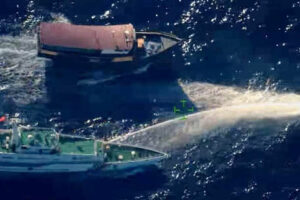By John Victor D. Ordoñez, Reporter
US DEFENSE Secretary Pete Hegseth on Thursday spoke on the phone with his Philippine counterpart Gilberto Eduardo Gerardo C. Teodoro, Jr. to discuss boosting deterrence in the South China Sea amid rising tensions with China, according to the US Department of State.
“The leaders discussed the importance of reestablishing deterrence in the South China Sea, including by working with allies and partners,” the US agency said. “They also discussed enhancing the capability and capacity of the Armed Forces of the Philippines.”
Mr. Hegseth reaffirmed Washington’s “ironclad” commitment to its Mutual Defense Treaty with Manila to secure peace in the Indo-Pacific region. He also vowed to work with Mr. Teodoro in boosting defense cooperation efforts between both countries.
“US-Philippine military deterrence efforts against China cannot contribute to the peaceful settlement of conflict in the South China Sea,” Rommel C. Banlaoi, chairman of the Philippine Institute for Peace, Violence and Terrorism Research, said in a Viber message.
Manila is better off pursuing diplomatic means and negotiation to resolve its dispute with Beijing and avoid the militarization of the South China Sea, he added.
Philippine and US air forces held joint patrols over the South China Sea on Tuesday, a move that angered China, which also conducted a “routine patrol” over the disputed Scarborough Shoal.
The one-day exercise by the treaty allies took place in the West Philippine Sea, Philippine Air Force spokesperson Maria Consuelo Castillo said, using Manila’s term for waters in the South China Sea that fall within its exclusive economic zone.
China’s military accused the Philippines of joining patrols that it said were organized by foreign countries to “undermine peace and stability” in the waterway.
While China has always maintained its presence in the waterway, claimed in part by the Philippines, Brunei, Malaysia, Taiwan, and Vietnam, tensions have risen over the past years as it continued engaging in dangerous activities, such as firing water cannons, shadowing, and ramming.
“It shows that Washington needs to strengthen further its alliance with Manila to boost deterrence in the South Chian Sea amid the great power rivalry in the region,” Chester B. Cabalza, founding president at Manila-based International Development and Security Cooperation, said in a Facebook Messenger chat.
Last month, US Secretary of State Marco Rubio talked about China’s “dangerous and destabilizing actions in the South China Sea” with Philippine Foreign Affairs Secretary Enrique A. Manalo and underscored the “ironclad” US defense commitment to Manila.
The US is the Philippines’ major security partner, with a 1951 Mutual Defense Treaty compelling both nations to defend each other in case of an armed attack.
The Philippines has been embroiled in wrangles at sea with China in the past two years and the two countries have faced off regularly around disputed features in the South China Sea that fall within Manila’s exclusive economic zone.
The US military has moved its Typhon launchers, which can fire multipurpose missiles up to thousands of kilometers, from Laoag airfield to another location on the island of Luzon, a senior Philippine government source said on Jan. 23, according to Reuters.
The Tomahawk cruise missiles in the launchers can hit targets in both China and Russia from the Philippines. The SM-6 missiles it also carries can strike air or sea targets more than 200 km away.
“The phone call is a sign of continuity to Washington’s ironclad commitment to the Philippines under the Trump administration,” Mr. Cabalza said.
Matthew Forbes Pottinger, a former deputy national security adviser of US President Donald J. Trump, on Feb. 3 said the US and its allies should limit China’s access to technology and data to curb its expansionist ambitions in the South China Sea through coordinated military deterrence.
“It would be better to constrain and temper Xi Jinping’s ambitions now through robust coordinated military deterrence and through strict limits on China’s access to technology, capital and data controlled by our countries,” he told a security forum in Manila.
The Philippines has contested China’s sweeping claim in the waterway through diplomatic channels by filing more than 190 diplomatic protests since President Ferdinand R. Marcos, Jr. took office in 2022.


















